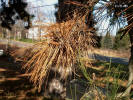 The fungus (Rhizosphaera kalkhoffii) attacks the older needles
found toward the inside of the tree. The tips of the branches are usually
not affected.
The fungus (Rhizosphaera kalkhoffii) attacks the older needles
found toward the inside of the tree. The tips of the branches are usually
not affected.
Infected needles will turn brown or purple and will eventually drop
from the tree. During the color change, tiny black dots may appear on the
needles. These are the fruiting bodies of the fungus. Spores will be released
from these dots during wet weather. Rain splashing will spread the infection
to other needles.
The lower branches on the tree are usually affected first. The infections
will gradually move up the tree leaving only the newer needles at the tips
of the branches. Severely infected branches lower on the tree may be killed.
Spread of the disease may be encouraged by prolonged periods of rain
or irrigation systems that spray onto the trees frequently. Although infection
may occur at any time in the year, most tend to get started in the spring.



